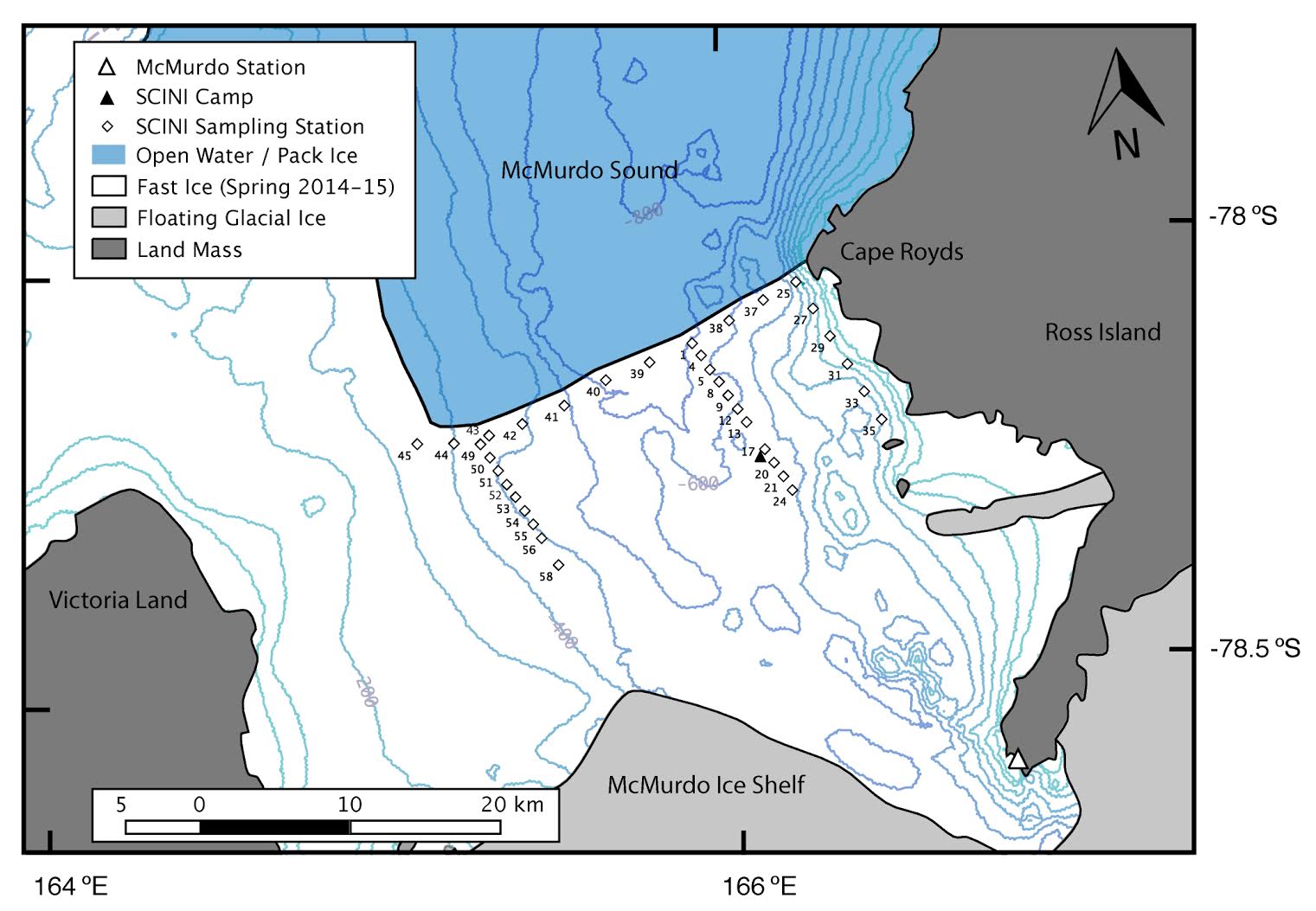Icebreaker dates and ice edge distance in McMurdo Sound, Antarctica from austral years 1956/1957 to 2014/2015 (McMurdo Predator Prey project)
Project
| Contributors | Affiliation | Role |
|---|---|---|
| Kim, Stacy | Moss Landing Marine Laboratories (MLML) | Principal Investigator, Contact |
| Ainley, David G. | H.T. Harvey & Associates | Co-Principal Investigator |
| Ballard, Grant | Point Blue Conservation Science | Co-Principal Investigator |
| Daly, Kendra L. | University of South Florida (USF) | Co-Principal Investigator |
| York, Amber D. | Woods Hole Oceanographic Institution (WHOI BCO-DMO) | BCO-DMO Data Manager |
This dataset contains dates of icebreaker start and arrival at McMurdo Station in McMurdo Sound, Antarctica between austral years 1956/1957 and 2014/2015. It also includes the distance between the fast ice edge and McMurdo Station on the date of ship arrival at the fast ice edge.
Data were acquired from scientist and icebreaker logbooks and contractor records (DACSUSAP2012-13, pers. comm. P. McGillivary USCG, see link below). See deployment: McMurdo_IceBreakers_1957-2015 for a list of icebreakers used.
External link to more information about ice-breaking services at McMurdo Station, Antarctica:
* DACSUSAP2012-13 Ice-breaking Services
Note: The arrival day "12" for the icebreaker Vladimir ignatyuk for the 2013 season is uncertain.
Blanks indicate no data were collected.
BCO-DMO Data Manager Processing Notes:
* added a conventional header with dataset name, PI name, version date
* modified parameter names to conform with BCO-DMO naming conventions
* blank values replaced with no data value 'nd'
* added data column "austral_year" for clarification when start year is before the austral year.
* added approximate latitude and longitude of sampling location near McMurdo Station.
| File |
|---|
Icebreaker.csv (Comma Separated Values (.csv), 3.98 KB) MD5:5ba16ba18828832f52becb8bba9189ba Primary data file for dataset ID 674992 |
| Parameter | Description | Units |
| austral_year | Austral year (start year/end year) in format yyyy/yy | unitless |
| start_year | Year of icebreaker arrival at the edge of the fast ice | unitless |
| start_month | Month of icebreaker arrival at the edge of the fast ice | unitless |
| start_day | Day of icebreaker arrival at the edge of the fast ice | unitless |
| arrival_year | Year of icebreaker arrival at McMurdo Station | unitless |
| arrival_month | Month of icebreaker arrival at McMurdo Station | unitless |
| arrival_day | Day of icebreaker arrival at McMurdo Station | unitless |
| edge_distance | Distance between the fast ice edge and McMurdo Station on the date of ship arrival at the fast ice edge. | kilometers |
| ships | Name of icebreaker vessel | unitless |
| lat_approx | Approximate latitude of sampling near McMurdo Station; Antarctica; south is negative | decimal degrees |
| lon_approx | Approximate longitude of sampling near McMurdo Station; Antarctica; west is negative | decimal degrees |
McMurdo_IceBreakers_1957-2015
| Website | |
| Platform | McMurdo Station |
| Start Date | 1956-10-28 |
| End Date | 2015-01-31 |
| Description | Icebreaker vessels used in McMurdo Sound for the seasons 1957 to 2015:
Atka
Polar star
Polar sea
Oden
Glacier
Krasin
Edisto
Burton island
Staten island
Vladimir ignatyuk
Healy
Northwind
Southwind
Eastwind
Westwind |
Food web dynamics in an intact ecosystem: the role of top predators in McMurdo Sound (McMurdo Predator Prey)
Extracted from the NSF award abstract:
The research project investigates the importance of top down forcing on pelagic food webs. The relatively pristine Ross Sea includes large populations of upper-level predators such as minke and killer whales, Adélie and Emperor penguins, and Antarctic toothfish. This project focuses on food web interactions of Adélie penguins, minke whales, and the fish-eating Ross Sea killer whales, all of which exert foraging pressure on their main prey, crystal krill (Euphausia cyrstallorophias) and silver fish (Pleuragramma antarcticum) in McMurdo Sound.
The investigators used a video- and acoustic-capable ROV, and standard biological and environmental sensors to quantify the abundance and distribution of phytoplankton, sea ice biota, prey, and relevant habitat data. The sampling area included 37 stations across an 30 x 15 km section of McMurdo Sound, stratified by distance from the ice edge as a proxy for air-breathing predator access. This study will be among the first to assess top-down forcing in the Ross Sea ecosystem and will form the basis for multidisciplinary studies in the future.
Map sampling stations

| Funding Source | Award |
|---|---|
| NSF Division of Polar Programs (NSF PLR) | |
| NSF Division of Polar Programs (NSF PLR) | |
| NSF Division of Polar Programs (NSF PLR) |
[ table of contents | back to top ]